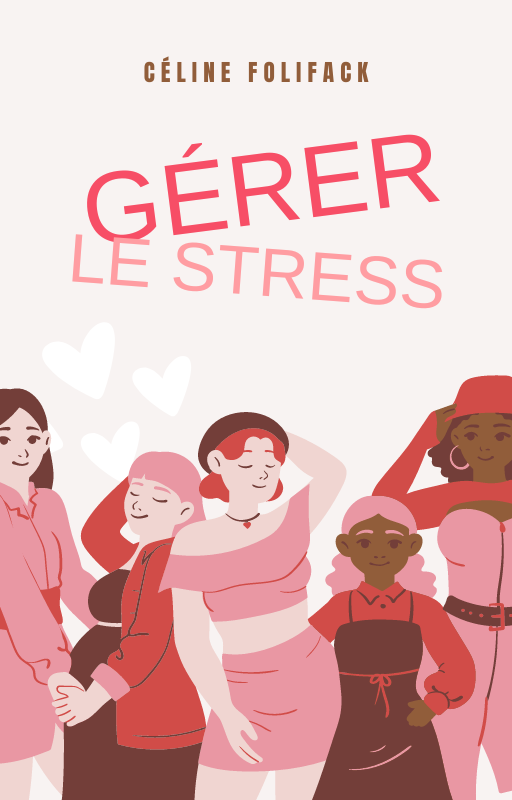
Comment gérer le stress? Cet exercice en deux parties vous invite à dresser la liste des symptômes physiologiques et émotionnels du stress et à réfléchir à sur les stratégies pour réduire, gérer ou éliminer ces sources de stress.
Gérer le stress: de quoi s’agit-il?
Trouvez de nouveaux mécanismes d’adaptation plus adaptatifs pour ces déclencheurs, afin de réduire ou éliminer les sources de stress dans votre vie.
À-propos du Guide pour gérer le stress :
Le Guide Gérer le stress contient deux parties.
1. La partie 1 est axée sur la connaissance de soi. Dans cet exercice, vous énumérerez les symptômes physiologiques et émotionnels de stress que vous ressentez face à des événements particuliers.
Évaluer vos niveaux de stress dans chaque circonstance vous aidera à prioriser ceux pour lesquels vous aimeriez faire face.
2. La partie 2 vous invite à réfléchir à de nouvelles façons plus saines de réduire ou d’éliminer votre stress.
Ici l’exercice vous demande d’identifier les éléments de ces déclencheurs de stress que vous pouvez ou ne pouvez pas contrôler, avant de concevoir des moyens d’y faire face dans l’instant.
Vous en voulez plus?
Découvrez notre Journal 52 semaines sans stress. Il contient une collection d’exercices pratiques de prévention et gestion du stress, qui comportent les outils plus efficaces et mieux notés, afin de vous aider à garder votre bien-être, vos énergies et votre joie dans un monde complexe.
Gérer le stress: téléchargez le Guide PDF
Remplissez simplement le formulaire ci-dessous. Et recevez en plus périodiquement de l’actualité inspirante.
Références
- Beck, J. S. (2011). Cognitive behavior therapy: Basics and beyond (2nd ed.). Guilford Press.
- Belvederi Murri, M., Ekkekakis, P., Magagnoli, M., Zampogna, D., Cattedra, S., Capobianco, L., Serafini, G., Calgano, P., Zanetidou, S., & Amore, M. (2019). Physical exercise in major depression: Reducing the mortality gap while improving clinical outcomes. Frontiers in Psychiatry, 9.
- Biegel, G. M., Brown, K. W., Shapiro, S. L., & Schubert, C. M. (2009). Mindfulness-based stress reduction for the treatment of adolescent psychiatric outpatients: A randomized clinical trial. Journal of Consulting and Clinical Psychology, 77(5), 855–866.
- Bratman, G. N., Hamilton, J. P., Hahn, K. S., Daily, G. C., & Gross, J. J. (2015). Nature experience reduces rumination and subgenual prefrontal cortex activation. Proceedings of the National Academy of Sciences, 112(28), 8567–8572.
- Carmody, J., & Baer, R. A. (2009). How long does a mindfulness-based stress reduction program need to be? A review of class contact hours and effect sizes for psychological distress. Journal of Clinical Psychology, 65(6), 627–638.
- Chafin, S., & Ollendick, T. (2001). A review of empirical studies of psychoanalytically oriented treatments for PTSD. Journal of Traumatic Stress, 14(2), 249–263.
- Cohen, S. (2004). Social relationships and health. American Psychologist, 59(8), 676–684.
- Cohen, S., Janicki-Deverts, D., Turner, R. B., & Doyle, W. J. (2015). Does hugging provide stress-buffering social support? A study of susceptibility to upper respiratory infection and illness. Psychological Science, 26(2), 135–147.
- Cohen, S., Kamarck, T., & Mermelstein, R. (1983). A global measure of perceived stress. Journal of Health and Social Behavior, 24(4), 385–396.
- Cohen, S., & Wills, T. A. (1985). Stress, social support, and the buffering hypothesis. Psychological Bulletin, 98(2), 310–357.
- Craft, L. L., & Perna, F. M. (2004). The benefits of exercise for the clinically depressed. Primary Care Companion to the Journal of Clinical Psychiatry, 6(3), 104–111.
- Frost, R., & Stimpson, N. (2020). Time management for health and social care professionals. Routledge.
- Goh, Y. W., Sawang, S., & Oei, T. P. (2010). The revised transactional model (RTM) of occupational stress and coping: An improved process approach. The Australasian Journal of Organisational Psychology, 3, 13–20.
- Hammen, C. (2005). Stress and depression. Annual Review of Clinical Psychology, 1(1), 293–319.
- Häusser, J. A., Mojzisch, A., Niesel, M., & Schulz-Hardt, S. (2010). Ten years on: A review of recent research on the job demand–control (–support) model and psychological well-being. Work & Stress, 24(1), 1–35.
- Hennefeld, J., & Battle, C. L. (2019). Relaxation techniques. In The SAGE encyclopedia of abnormal and clinical psychology (pp. 2944–2946). SAGE.
- Hobfoll, S. E. (1989). Conservation of resources: A new attempt at conceptualizing stress. American Psychologist, 44(3), 513–524.
- Hobfoll, S. E., Halbesleben, J., Neveu, J. P., & Westman, M. (2018). Conservation of resources in the organizational context: The reality of resources and their consequences. Annual Review of Organizational Psychology and Organizational Behavior, 5, 103–128.
- Hofmann, S. G., Asnaani, A., Vonk, I. J., Sawyer, A. T., & Fang, A. (2012). The efficacy of cognitive behavioral therapy: A review of meta-analyses. Cognitive Therapy and Research, 36(5), 427–440.
- Hoge, E. A., Bui, E., Marques, L., Metcalf, C. A., Morris, L. K., Robinaugh, D. J., Worthington, J. J., Pollack, M. H., & Simon, N. M. (2013). Randomized controlled trial of mindfulness meditation for generalized anxiety disorder: effects on anxiety and stress reactivity. The Journal of Clinical Psychiatry, 74(8), 786–792.
- Karasek, R., Brisson, C., Kawakami, N., Houtman, I., Bongers, P., & Amick, B. (1998). The Job Content Questionnaire (JCQ): An instrument for internationally comparative assessments of psychosocial job characteristics. Journal of Occupational Health Psychology, 3(4), 322–355.
- Kivimäki, M., Nyberg, S. T., Batty, G. D., Fransson, E. I., Heikkilä, K., Alfredsson, L., Bjorner, J. B., Borritz, M., Burr, H., Casini, A., Clays, E., De Bacquer, D., Dragano, N., Ferrie, J. E., Geuskens, G. A., Goldberg, M., Hamer, M., Hooftman, W. E., Houtman, I. L., … Theorell, T. (2012). Job strain as a risk factor for coronary heart disease: A collaborative meta-analysis of individual participant data. Lancet, 380(9852), 1491–1497.
- Lazarus, R. S., & Folkman, S. (1984). Stress, appraisal, and coping. Springer.
- Park, C. L. (2010). Making sense of the meaning literature: An integrative review of meaning making and its effects on adjustment to stressful life events. Psychological Bulletin, 136(2), 257–301.
- Pascoe, M. C., Thompson, D. R., & Ski, C. F. (2017). Yoga, mindfulness-based stress reduction and stress-related physiological measures: A meta-analysis. Psychoneuroendocrinology, 86, 152–168.
- Salmon, P. (2018). Effects of physical exercise on anxiety, depression, and sensitivity to stress: A unifying theory. Clinical Psychology Review, 57, 117–131.
- Schmidt, S., Mrazek, M. D., & Haggard, M. (2019). Mindfulness in the workplace. Oxford research encyclopedia of psychology. Oxford University Press.
- Spielberger, C.D., Gorsuch, R. L., Lushene, R., Vagg, P. R., & Jacobs, G. A. (1983). Manual for the State–Trait Anxiety Inventory. Consulting Psychologists Press.
- Stults-Kolehmainen, M. A., & Sinha, R. (2014). The effects of stress on physical activity and exercise. Sports Medicine, 44(1), 81–121.
- Sui, X., Ladwig, M. A., Singh, G., & Friston, K. J. (2019). Exercise and the aging brain: Fit body, fit mind? Progress in Neurobiology, 172, 45–56.

Fondateur et éditeur de KifYou.
